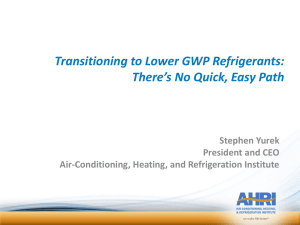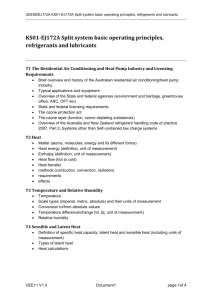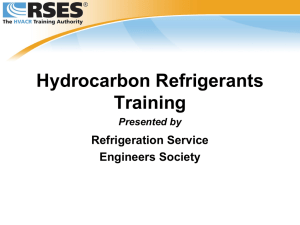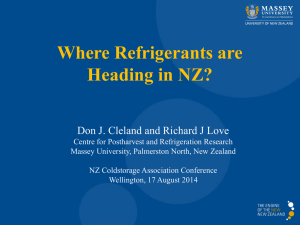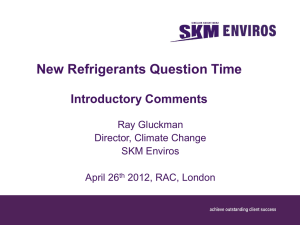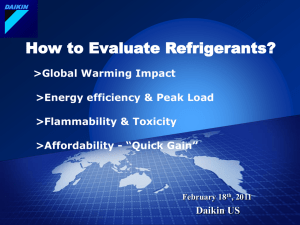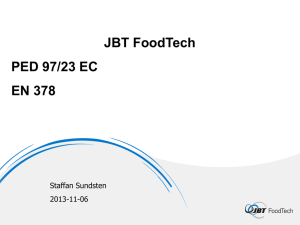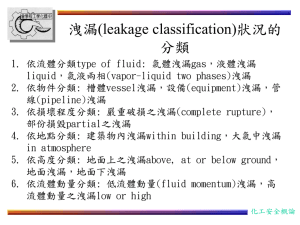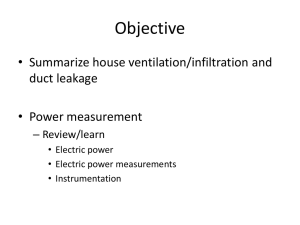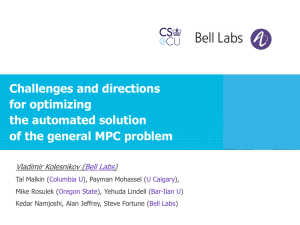PowerPoint *********
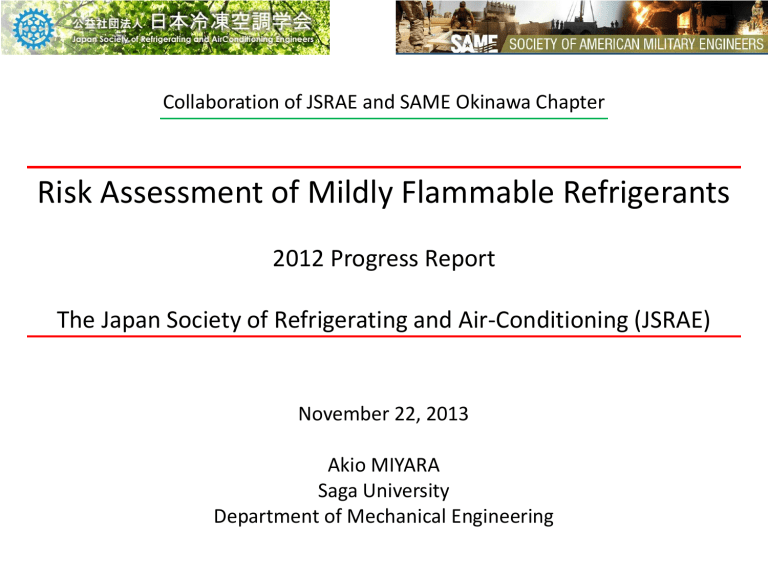
Collaboration of JSRAE and SAME Okinawa Chapter
Risk Assessment of Mildly Flammable Refrigerants
2012 Progress Report
The Japan Society of Refrigerating and Air-Conditioning (JSRAE)
November 22, 2013
Akio MIYARA
Saga University
Department of Mechanical Engineering
Contents of the report
1 Introduction
2 Legal issues with mildly flammable refrigerant
2-1 Explanation of high pressure gas safety law and legal issues with mildly flammable refrigerant
2-2 Current international trends regarding refrigerant
3 Research on safety of mildly flammable refrigerants
3-1 Progress of the University of Tokyo
3-2 Research and development of low-GWP refrigerants suited to heat pump systems
3-3 Physical hazard evaluation of A2L-class refrigerants using several types of conceivable accident scenarios
3-4 Progress report by research Institute for Innovation in Sustainable Chemistry, AIST
3-5 Physical hazard evaluation on explosion and combustion of A2L class refrigerants
4 Progress of the Japan Refrigeration and Air Conditioning Industry Association (JRAIA)
4-1 Mini-split air-conditioner risk assessment SWG: The risk assessment result of the residential air-conditioner, and the study of the mini-split air-conditioner for small business use
4-2 VRF risk assessment SWG: The 1st risk assessment of VRF system with A2L refrigerant and future
4-3 Chiller risk assessment SWG: Risk assessments policy of the chiller and guideline planning taking
IEC60079 into consideration
5 Deregulation activities in Japan for the introduction of mobile air conditioning refrigerant R1234yf
File can be downloaded from “ http://www.jsrae.or.jp/info/2012progress_report_e.pdf ”
Background
Necessary & Indispensable Technology
Comfortable life
Survive
Refrigerating
Cold storage
Refrigerator car
Cold chain
Sustainable society
Freezing
Vapor compression system
Adsorption system
Refrigerator
Data center
Clean room
House
Food supply
Medical & Biological fields
Industrial process
1
Industrial fields
Automobile
Hospital
Office
Building
Air-Conditioning
Cooling system
Drying
Hot water
Heat Pump
Heating
Combustion
3
Background
Need to Build Low-Carbon Society
• Montreal Protocol (1987)
• Phase out of ozone depletion gasses, CFCs, HCFCs, etc.
• Developed countries
• CFC: 1995 (Phase out was completed in Japan)
• HCFC: 2020 (Production is being reduced)
• Developing countries
• CFC: Phase out in 2010 (start from 1999)
• HCFC: Phase out in 2040 (start from 2016)
• Alternative refrigerants: HFCs (R134a, R410A, etc. )
• Successful replacement
• Kyoto Protocol (1997)
• Reduction of greenhouse gases, CO
2
, HFCs(R32, R410A, etc.) , etc.
• Developed countries
• Average reduction of 5.2% reduction from 1990 level by the year 2012
• 6% reduction for Japan, F-gas regulation in Europe
• IPCC Fifth Assessment Report: Sep. 2013 ~ Oct. 2014
Motivation
Next Generation Refrigerants
• Natural refrigerants
• HC in refrigerator, CO
2 in HP water heater, NH
3 in industrial …
• Tentative continuous use of HFCs for midway
•
• Refrigerant management
Refrigerant leakage, Refrigerant tracking, Engineers skill, …
• R32 is now being promoted.
• Low GWP synthetic refrigerants: HFOs
• R1234yf for mobile AC, R1234ze(E) for turbo chiller,
R1234ze(Z) for heat pump in high temperature range …
• other HFOs, R1234ye, R1233zd, R1243zf, R1225
Study on Properties, Heat transfer , Dropin test, …
• Refrigerant mixtures
•
•
• Limitation of pure refrigerant properties
Suitable properties such as pressure, flammability, …
Property measurements, Cycle simulation, Dropin test, …
Introduction by Eiji HIHARA, University of Tokyo
Summary of the proposed regulation of HFCs
Revise the Montreal Protocol (US, Canada, Mexico)
Restriction of production and sales of HFCs
EU protocol on mobile air-conditioning refrigerants
GWP < 150 from January 1, 2011
F-gas Regulation for stationary air-conditioners
Reducing leakage, Proper management, Instruction courses,
Labeling, Report by producers/importers/exporters
Proposed phasedown schedule of HFCs
Proposal by US, Canada, Mexico
Developing countries
Developed countries
Proposal by EU Commission
Emissions of HFCs in Japan -present situation-
Total CO
2 emission of HFCs[million-t] others
Ref. & AC million-t CO
2
In dispose
In use
Leakage
Small refrigerator
Large refrigerator
Medium refrigerator
Package AC for building
Other business use
Room AC
Show case (split-type)
Trend in mildly flammable refrigerants
Environment-friendly refrigerants
Zero ODP (ozone depletion potential)
Low GWP (global warming potential)
Refrigerants for room and package air-conditioners
HFOs
R1234fy
R1234ze(E)
ODP=0, GWP=4
ODP=0, GWP=6
Mildly flammable
HFCs
R32 ODP=0, GWP=675 rank 2L on ASHRAE Standard 34
(note: most of other HFCs: GWP>1000)
Requirement of risk assessment
Methodology of risk assessment
Burning characteristics of flammable refrigerants Mechanism of ignition
Probability of ignition
= (Leakage) X (High concentration) X (Ignition source) X (Low air velocity)
Research on safety of mildly flammable refrigerants
By
Eiji HIHARA, Tatsuhito HATTORI, Makoto ITO
University of Tokyo
Leakage of mildly flammable refrigerants
Simulation conditions of leakage of refrigerants
Room air conditioners (RAC)
Leakage scenarios
Variable refrigerant flow air conditioning systems for building (VRF)
Simulation results of leakage of refrigerants
Leak of R32 from wall-mounted indoor unit of RAC
Simulation model Simulation result isosurface of concentration at LFL (13.3 vol%)
Leakage scenario
No Position of leakage
1 Wall-mounted indoor unit
Refrigerant
R32
Amount
[g]
1000
Flow rate
[g/min]
250
Combustion does not occur if the ignition source does not exist inside the indoor unit.
Simulation results of leakage of refrigerants
Leak of R32 from floor-mounted indoor unit of RAC
Simulation model Simulation result isosurface of concentration at LFL (13.3 vol%)
Leakage scenario
No Position of leakage
9 Floor-mounted indoor unit
Refrigerant
R32
Amount
[g]
1000
Flow rate
[g/min]
250
The leakage of flammable refrigerants from a floor-mounted indoor unit has a high risk of combustion.
Simulation results of leakage of refrigerants
Leak of R32 from outdoor unit of RAC in balcony
Simulation model Simulation result isosurface of concentration at LFL (13.3 vol%)
Leakage scenario
No Position of leakage
11 Outdoor unit
Refrigerant
R32
Amount
[g]
1000
Flow rate
[g/min]
250
The leakage of flammable refrigerants from an outdoor unit has a high risk of combustion.
Note: Drains and under cuts shorten the presence of the gas.
Simulation results of leakage of refrigerants
Leak of R32 from ceiling-mounted indoor unit of VRF
Simulation model Simulation result isosurface of concentration at LFL (13.3 vol%)
Leakage scenario
No Refrigerant
3 R32
Amount
[kg]
26.3
Flow rate
[kg/h]
10
Forced air
[m 3 /h]
0
Air vent exists
A combustion gas region only exists just below the air outlet and the suction of the VRF, even if the entire quantity of refrigerant is discharged.
Simulation results of leakage of refrigerants
Time variation of concentration of R32
Research and development of low-GWP refrigerants suitable for heat pump system
By
Shigeru KOYAMA, Kyushu University
Yukihiro HIGASHI, Iwaki Meisei University
Akio MIYARA, Saga University
Ryo AKASAKA, Kyushu Sangyo University
Flammability
Toxicity
Thermodynamic properties
Transport properties
Heat transfer
Heat pump cycle
Drop-in experiments of pure HFO and HFO+HFC
Drop-in experiments of pure HFO and HFO+HFC
Drop-in experiments of pure HFO and HFO+HFC
